Another week has passed and we edge ever closer to the silence of winter in the bee yard. To say that I’m not looking forward to that silence would be an understatement.
I have grown accustomed to sitting by my hives and watching the bees coming and going as they forage for pollen and nectar. It is a remarkably calming activity. So, as cold weather approaches, I have already begun planning for next season with resource hives and nucs being my primary focus.
But, before I talk about hive updates and my planning activities for next season, I want to take a few moments and muse about changing colors, cooling temperatures, and the beauty of the natural world that surrounds us.
Early Morning Bee Musings
Sitting in the coffee shop on this early Saturday morning, I started musing about the beauty in these mountains in western North Carolina. At heart, I will always be a mountain man. We are fortunate in this bit of heaven on earth to have four pronounced seasons (well most of the time anyways).
But, global warming has arrived in these mountains as well, with warmer winters and hotter summers. Regardless, the trees know that the fall solstice has passed and they are beginning to display the beauty of the natural world surrounding us.
Now don’t get me wrong, I love summer and my flowers. But, I also love having four seasons to see the natural order of things working like clockwork. Fall is truly one of the most beautiful seasons in this deciduous forested region.
Next week, I will be journeying up into the mountains to enjoy the natural beauty and embrace my hippy, nature-loving side. I’ll be sure to include pictures in next week’s blog.
I think in some ways Beorn’s Acres Apiary is the perfect name for my bee yard. Yes, you’re about to get a soliloquy about Tolkien again (you’ll just have to grin and bear it). As I look at the world around me, I see how humans damage the beauty day-in and day-out. A particular type of damage that pains me is seeing perfectly healthy trees cut down for “progress”.
Yes, I’m not only a hippy, nature-loving beekeeper but I am also one of those tree-hugging varieties. Fall always reminds me of the majesty of trees and the role they play in keeping us alive and breathing.
In some respects, Tolkien had it right when he remarked in one of his letters that “wouldn’t it be great if the trees could fight back.” Thus was born the Ent, which did fight back much to the chagrin of the twisted wizard, Saruman.
Fall makes me appreciate the natural beauty surrounding me even more. No matter where I may visit or live, there is a part of these mountains and their trees deep in my soul. And, those trees play a role in our honeybees lives as well as they visit sourwood trees, locusts, apple trees, and more. In this region, the trees play an integral role in the varieties of honey created during different periods in the spring, summer, and fall.
So why this long digression you ask? No real reason my faithful readers. It was just a moment I was taking to stop and appreciate the beauty around me. And, just maybe, it will make some of you step back and take stock of the beauty where you live as well.
Last week, we talked about flowers that honeybees like. I sure hope you enjoyed that as much as I did writing it. I truly only touched the proverbial tip of an iceberg in my blog post and encourage any of you interested to seek out some of my suggested resources.
So before we talk about this weeks topic, let’s visit the happenings in the bee yard.
Hive Updates
This week brought some welcome changes and interesting developments in the bee yard. These were mostly centered around Hive Rome but signs of the colonies preparing for winter are clearly evident now.
Hive Rome
I performed two inspections on Hive Rome this week. My reasoning for this was to determine the status of the colony after adding a frame of honey and brood during last week’s inspection.
Hive Rome is still way too light on bees for my comfort level to be truly confident. But, for the first time in many weeks, I found some significant honey stores starting to appear in this colony’s very empty frames. Additionally, the frame of honey I transferred from Hive Florence is largely intact.
It appears that about 7 or 8 cells had been robbed of honey. The remaining honey on this frame is intact. In fact, the robbing has completely ceased. I’ll return to why I think that is the case shortly.
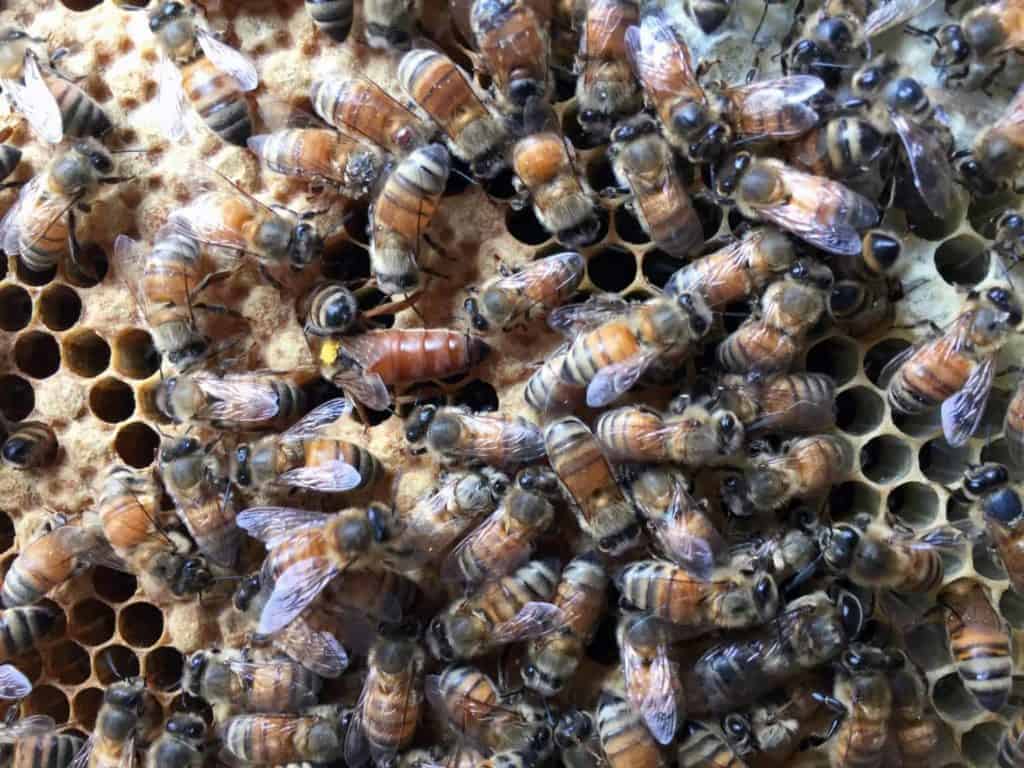
Cornelia has begun to lay significant amounts of eggs. She was actively searching for more empty cells in which to lay eggs as I examined the brood. The brood pattern is shaping up to be quite exceptional as well.
There is now at least one whole frame of a few hundred eggs. By the time these hatch, likely by Monday, there will be larvae for the nurse bees to feed and care for. After this initial inspection, I followed up with a second on Saturday afternoon.
By Saturday afternoon, one of the two quart boardman feeders was three quarters drained. In just a couple of days, the amount of honey stores had increased measurably. Naturally, they don’t have enough honey stores for winter, given all that this poor colony has experienced but things are moving in the right direction now.
I refilled the feeders before closing up Hive Rome. So, my plan of action to assist this colony is fourfold:
- Combine a few frames of honey and brood from Hive Florence, using the newspaper method, to increase the population of bees and assist with foraging and nursing duties,
- Feed heavily until it gets too cold for providing sugar water and then convert to fondant until cold weather prevents me from opening the hive,
- Feed the colony raw pollen directly to assist with brood rearing until they have a critical mass of foragers and nurse bees, and
- Monitor progress continually.
I think there is an increasingly good chance that this nucleus colony will go into winter as ready as I can possibly make them.
So Why Did the Robbing Attacks End?
After weeks of robbing attacks, they just as suddenly ended as when they began. Last week, you may remember that I discovered that many of the robbing bees were making a bee-line to my neighbor’s house, who installed two small hives a few weeks ago. So, I suspected at least some of the robbing was happening from her hives.
I also knew that by coloration and markings on some of the robbing bees they were coming from Hive Olympus (naughty Carniolans). So, why did the robbing so suddenly stop? I have a few theories to explain this fact:
- My neighbor started feeding her bees early this week and has kept feeders on the hives ever sense. With no need to leave home to find ready sugar water, I believe many of her bees stayed at home.
- I have kept my own bees consistently fed refilling the hive top feeders every two to three days. Again, with no need to go look elsewhere, they are focusing on staying nearer to home.
- The weather is cooling significantly in the past week. Even though the bees are coming in heavily laden with pollen, things are slowing down and the bees are focusing on raising winter bees and stocking up their honey stores for winter.
Hive Acquitaine
This week I really wanted to inspect Hive Acquitaine very carefully. It has been a few weeks since I have actually seen Eleanor and now it the time that we need to ensure that our colonies are queenright. I also wanted to find out how well the colony is doing preparing winter stores.
When I opened the hive, I found an almost empty top hive feeder. All colonies are readily taking the sugar water but Hive Acquitaine is really making good use of their food.
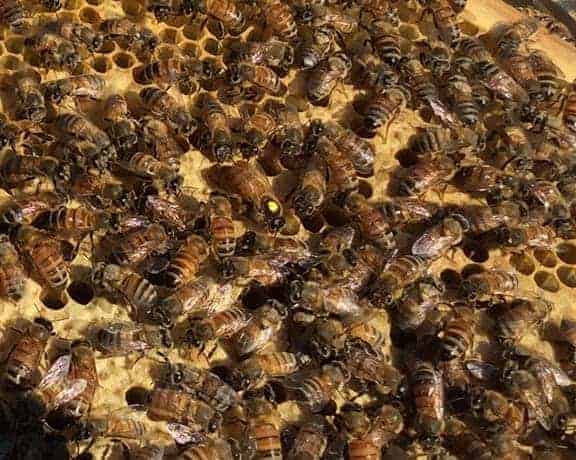
Setting aside the top hive feeder, I began inspecting the medium box. A couple of weeks ago, this colony was only beginning to store some honey in the medium frames. At that time, I transferred a total of four medium frames of honey, two each from Hives Florence and Olympus, to jump-start their production.
This experiment turned out to be an enormous success. In the intervening two weeks, the colony has been busy filling up the comb on the remaining six frames with honey. At the rate they are storing honey in this mostly new comb, they will have a full medium box in a couple of weeks. That will make me three for three with a medium box honey dome above the two brood boxes.
Moving on to the upper brood box, I found deep frames heavily laden with honey. And I mean very heavily laden. The bees have actually built out the comb significantly beyond the frame sometimes connecting two frames together and storing honey throughout.
In the center of the upper brood box, I found recently laid eggs along with larvae and capped brood. Finding eggs meant that I knew Eleanor was present but needed to find her. After inspecting all the frames in the upper brood box, I still had not found Eleanor.
Proceeding to the lower brood box, I found significantly heavy honey frames and more brood. I also finally spotted Eleanor wondering around looking for free cells to deposit eggs. She’s busily at work creating winter bees for the colony. I was relieved to see her after so many weeks.
I quickly reassembled the hive and refilled the top hive feeder. This colony is quite satisfying to me because it was my first split and for weeks this summer I just wasn’t sure if it was going to take off. Now, I feel like there is an better than even possibility that this colony will make it through winter.
Hive Olympus
Since it had been two weeks since I inspected Hive Olympus, I was curious to see how they had done replacing the honey I took from the medium box for Hive Acquitaine. When I opened the hive, I found that they had not completely drained either reservoir of the top hive feeder. What’s more, the top hive feeder had significant quantities of small hive beetle larvae.
This colony has been plagued with these larvae in the feeder, off and on all summer. I am ordering Beetle Blasters to place in all my hives to attempt a final cleanup of any small hive beetles hiding out in the hive. I decided to drain the top hive feeder and destroy any remaining larvae.
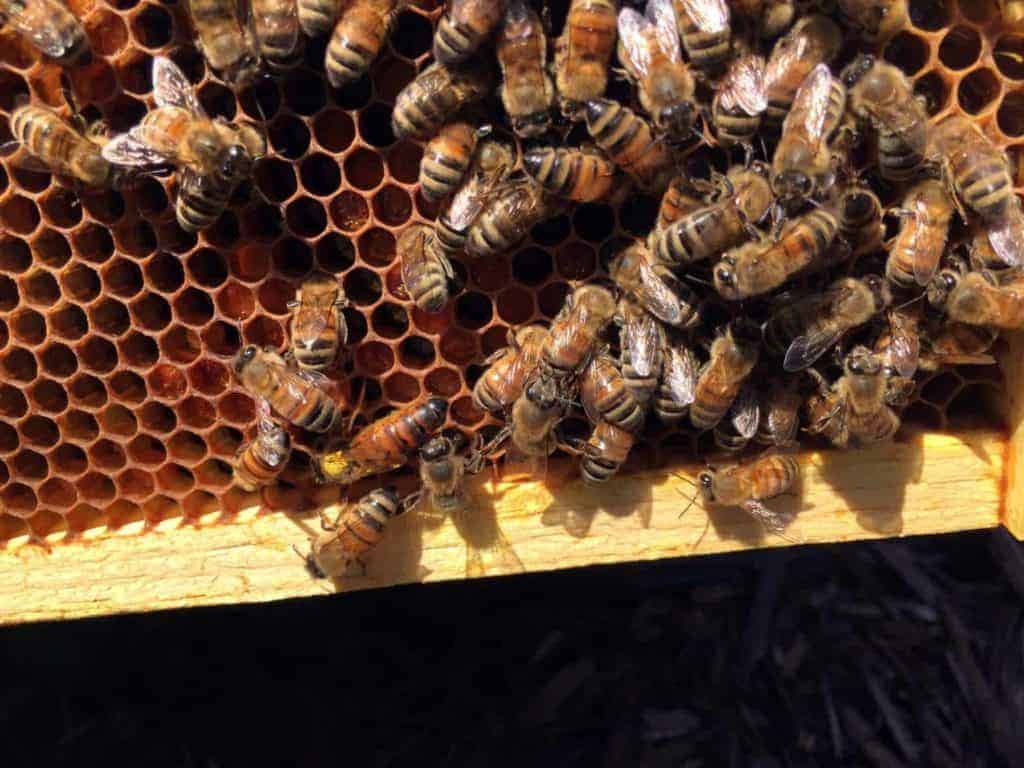
Examining the medium box, I was curious to see if they had made progress filling the two empty medium frames with honey. I shouldn’t have had any doubts.
They had filled those frames with honey and decided to make my work harder by building burr comb attaching the upper brood box’s and the medium box’s frames together. Yes, more reconstructive work to remove the burr comb was requisite.
I can’t quite figure out why this colony is so intent on building burr comb between these two boxes. If one of you more seasoned beekeepers reads this and has an idea, please respond and educate me!!
Moving on to the upper brood box, my inspection revealed ample supplies of honey on the deep frames on the outer two edges of the box. And when I say ample, I mean so heavy that it was difficult to lift them out of the box cleanly.
Moving into the central frames, I found newly laid eggs, larvae in all instages of development, and significant capped brood. Athena has proven to be nearly as productive as her mother, Hecate. Of course, I didn’t find Athena two weeks ago when I inspected Hive Olympus and she wasn’t about to be found in the upper deep box.
So moving along to the lower brood box, I began a focused search for Athena. The lower brood box was just as heavily stocked with honey stores. And, Athena had been busy populating the central frames with brood.
Finally, I saw her wandering across a frame of brood looking for more places to lay eggs. So that decisively ended any worries I had about my queens. All four colonies are queenright! With everything proving to be well in this hive, I began reassembling it and refilled the top hive feeder before closing it up.
Hive Florence
I decided to not inspect Hive Florence this week. My inspections of Hives Acquitaine and Olympus had taken me to about 4:30 PM and with the weather cooler I didn’t want to open the hive. But, I opened the top to see if the top hive feeder needed to be refilled.
Hive Florence drinks sugar water like it is in endless supply. This colony can drain the top hive feeder in two days flat. So, I refilled the top hive feeder and closed the colony back up. With hurricane influenced rains coming on Sunday and Monday, this will need to tide them over until the rains stop.
So my bee yard contains four queenright colonies, three of which are in good shape for winter and a nucleus hive that is beginning to show very positive signs of growth. All things considered, I believe my efforts are paying off for my bees.
With my Apivar treatment ending on October 31st for the three large colonies and a week later for the nucleus colony, I think I have a good control of any Varroa Mite population (yes I will test when the Apivar is removed). I also believe I have given the colonies the ability to store enough food for even a truly cold mountain winter.
I am hopeful that my work will see four colonies through winter and ready me for my second season of beekeeping.
Preparing for Next Season
As I have been preparing for winter and getting my colonies ready for the cold months, I have been putting a lot of thought into my second season as a beekeeper. So, for this blog post, I am going to share some of my thoughts on what I have been planning for the upcoming season.
As I progressed through this first season of beekeeping, I experienced queen issues a couple of times. I also experienced the frustration of not having mated queens readily available. It wasn’t often convenient or easy to find a replacement. As a result, I became interested in queen rearing. Having experienced two splits in my first summer of beekeeping, I decided I better be ready to make four splits come spring. So, I began looking at queen castles and resource hives.
What’s a Resource Hive?
The Resource Hive is basically a modified deep body that turns the deep into two nucs. The two nucs in the deep may then stack two nuc bodies atop with individual nuc inner covers and a telescoping top cover.
The bottom board for a Resource Hive has alternate entrances for each chamber to prevent drifting between the colonies. Resource Hives are great for overwintering Nucs and may also be used as a tool for raising queens and creating splits. You may also put a Resource Hive to work to boost weaker colonies with brood.
The concept of using nucs as resource hives was first brought to the beekeeping world by Michael Palmer of French Hill Apiaries in St. Albans, Vermont. He was introduced to the concept of using nucs when visiting a fellow beekeepers apiary and seeing nucs with bearding bees, in other words, full nucs being used as resources within the apiary.
After researching his friends techniques in more detail he learned that his fellow beekeeper was replicating the techniques first introduced for overwintering nucs by Brother Adam of Buckfast Abbey in England.
Brother Adam was a Benedictine monk. Now, I have to admit that being a former medievalist who considered a doctoral program in English literature, the thought of a monk pioneering these techniques both appeals to me and amuses me at the same time.
Putting My Resource Hive to Work
A few weeks ago, I purchased a Resource Hive. This resource hive divides the deep body into two four frame nuc bodies. As you can see in the pictures, it meets the specification of a resource hive that I described above.
With the resource hive, I now have two five frame nucs and essentially two four frame nuc bodies. This gives me room to make four splits from my colonies this spring to get my resource hive production in place. I am considering using my nucs to start a queen-rearing production to build new nucs to supply to fellow beekeepers and my own apiary.
We have a severe issue with readily available queens in our area and so I would like to get involved in the process of filling a gap that I have seen all too well myself in my first season. So, my winter will be spent learning the techniques that Michael Palmer and Brother Adam are putting to use with the Resource Hive. It will involve a significant amount of research about these techniques. So this blog post is just the first of likely a series where I will share what I’m learning about these techniques.
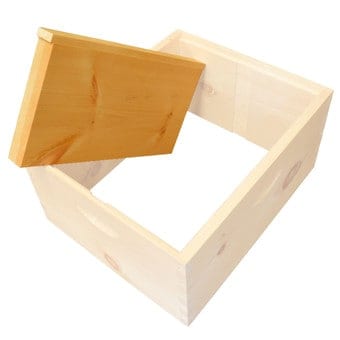
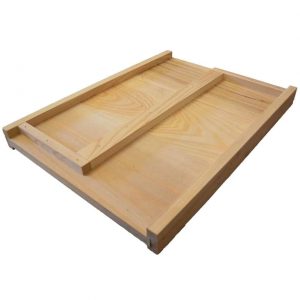
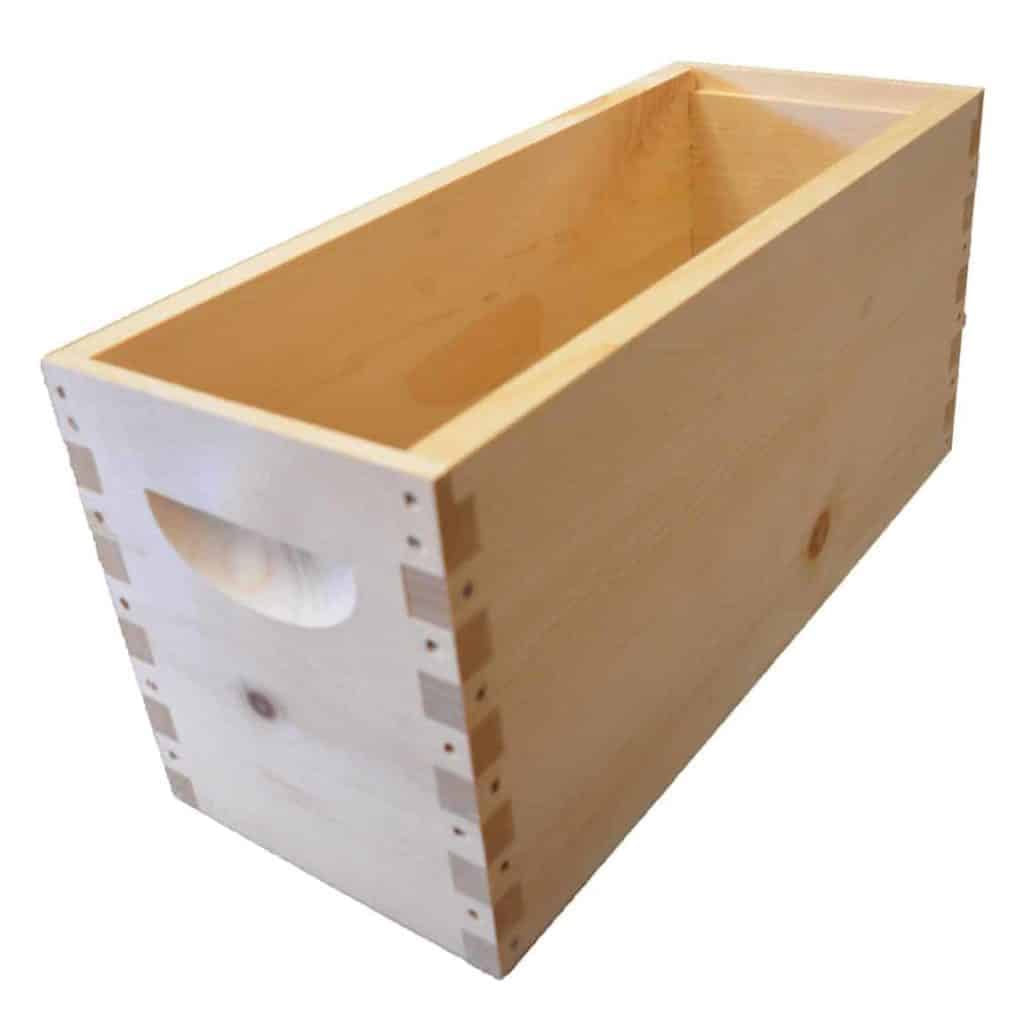
Reading Material about Resource Hives and Brother Adam’s Techniques
There are a number of notable resources that you might consult if you are interested in this topic including books and recordings of lectures given by Michael Palmer.
Books
- Brother Adam. Beekeeping at Buckfast Abbey.
- Brother Adam. Breeding the Honeybee.
- Brother Adam. 2nd Edition. In Search of the Best Strains of Bees.
- Connor, Lawrence John. Increase Essentials.
Online Resources
- Michael Palmer of French Hill Apiaries
A compilation of information from Michael Palmer compiled by Two Little Ladies Apiary. - Bees Past & Present – Buckfast Abbey
- The Common Races of Honey Bees
Stay tuned for more on the resource hive in the future.
What’s a Queen Castle?
The Queen Castle is a tool used by many beekeepers for queen rearing. The Queen Castle may be used to house a frame with a queen cell. Essentially, the typical deep queen castle uses dividers to yield four 2-frame nucs or two 5-frame nucs. The medium queen castle may be divided into three 2-frame nucs.
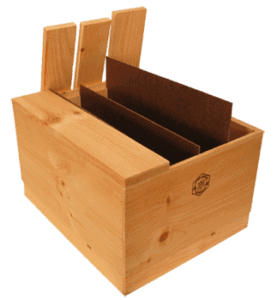
A Queen Castle has a bottom board that provides each nuc its own entrance on different sides of the box, as well as ventilation from below to help each nuc maintain temperature. A Queen Castle also requires a standard 10-frame telescoping top.
The concept of a queen castle – let’s take the four 2-frame division as an example – works by taking a frame with a queen cell and either adding a frame of honey or a feeder for the bees. Within two to three weeks, if all goes well, you have a newly mated queen and a starter colony.
Again, I will be doing more research and hopefully writing more on this in the near future. Consider this a starter into learning about increasing your apiary through nucs and rearing queens in queen castles.
Reading Material about Queen Rearing
The topic of queen rearing is explained in any number of quality books that are readily available to beekeepers.
Books
- Connor, Lawrence John. 2nd Edition. Queen Rearing Essentials.
- Spivak, Marla, and Gary Reuter. Successful Queen Rearing Short Course.
- Laidlaw, Jr., Harry H. Contemporary Queen Rearing.
- Connor, Lawrence John. Bee Sex Essentials.
- Doolittle, G. M. Scientific Queen-Rearing.
- Smith, Jay. Better Queens.
- Smith, Jay. Queen Rearing Simplified.
Coming Next Week
Next week, I’ll give you more updates on how my colonies are readying themselves for winter. I also hope to produce some photographs of the Hive Rome so you can see its progress. As the colony is actively eating sugar water and eating the raw pollen I have supplied, I am looking forward to updating you about their progress.
As I will be traveling to our corporate offices in Portland, Oregon, next Monday, I will likely write a more abbreviated post. If any of you have a topic which you have questions about, post a response to this blog post. I may just use your suggestion as the focus of next week’s blog post.
Until next time, Happy Beekeeping!
